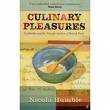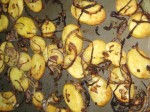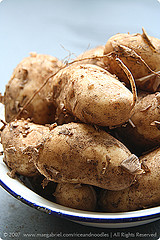The Capital Hotel’s Eric Chavot played a blinder on last weekend’s Saturday Kitchen. He was amusing, watchable and enigmatic, and the dish he created looked fab. Shame he let slip the f-word towards the end of the show and thus gave the Daily Mail free rein to vilify him …
My terribly clever WordPress dashboard registered a healthy dollop of traffic around Eric’s name after the programme, which spurred me to explore the chefs and cookery writers delivering the best footfall for me on this blog. So, pop pickers, here is my top ten of Lewis blog foodies. Dah Dah, da-da Dah, der der der, der der der, Dah Dah, da-da Dah … etc.
- 10th: Fergus Henderson
- 9th: Alain Ducasse
- 8th: Allegra McEvedy
- 7th: Delia Smith
- 6th: Elizabeth David
- 5th: Eric Chavot
- 4th: Nigel Slater
- 3rd: Madhur Jaffrey
- 2nd: Jun Tanaka
- 1st: Marcella Hazan
But what does this tell me about the relative pulling power of food stars, and the nature of chefdom, apart from the fact that I should clearly cook a dish from Marcella’s classical Italian repertoire every night if I want to grow my audience?
First, isn’t it interesting that two of the darlings of the food scene, Fergus and Alain, are way off the pace? Both are great chefs, and Alain occupies a place in the stratosphere of chef legends; but clearly their entrails and extravagance haven’t struck a chord with my visitors. Could it be that few domestic fridges harbour foie gras or trotters?
Second, how revealing that the top three should be booktastic, all, Madhur and Marcella having forged long and glittering literary careers from producing standard texts, Jun having only weeks ago brought out a popular new tome, Simple to Sensattional?
The message is that producing books of recipes that are attainable, tasty and rooted in a specific regional cuisine ensures a loyal following. In years to come, Jun (a really nice fellow) might have built up such a canon or work. Meanwhile, I would expect his name to be searched on less and less in the coming weeks, as more of his peers bring out new books. Ah, but “Fame is a fickle food upon a shifting plate”.
[The post was brought to you by Emily Dickinson and WordPress]
Filed under: Uncategorized | Tagged: Alain Ducasse, Allegra McEvedy, Capital Hotel, Delia Smith, Elizabeth David, Eric Chavot, fergus henderson, Jun Tanaka, Madhur Jaffrey, Marcella Hazan, nigel slater, Saturday kitchen, simple to sensational | 2 Comments »


 Bank holiday Monday; Susie was working. I went for a cycle, washed the dishes from last night, mopped the kitchen floor, found some great sounds on Spotify (Philip Glass, Arvo Part, Stereolab and the Dead Boys), and read my book (Dead Air by Iain Banks; promising so far …) in the garden. With rain in the air, I then came in and slumped in front of the telly, where Glynn Purnell, James Sommerin et al were trying to impress Oliver Peyton, Pru Leith and Matthew Fort in the new series of the
Bank holiday Monday; Susie was working. I went for a cycle, washed the dishes from last night, mopped the kitchen floor, found some great sounds on Spotify (Philip Glass, Arvo Part, Stereolab and the Dead Boys), and read my book (Dead Air by Iain Banks; promising so far …) in the garden. With rain in the air, I then came in and slumped in front of the telly, where Glynn Purnell, James Sommerin et al were trying to impress Oliver Peyton, Pru Leith and Matthew Fort in the new series of the  One of my fondest childhood food memories is of eating freshly baked
One of my fondest childhood food memories is of eating freshly baked 









 London food blogger extraordinaire, MsMarmitelover, has
London food blogger extraordinaire, MsMarmitelover, has  Sunday’s supper was
Sunday’s supper was  I’ve just started reading a book that aims to trace Britain’s culinary evolution through the lens of its cookbooks. It’s called
I’ve just started reading a book that aims to trace Britain’s culinary evolution through the lens of its cookbooks. It’s called  Looking back over my last five posts, I see that I’ve reported on eating steak, lamb chops and lamb shanks. This is pretty much in line with global statistics. According to the
Looking back over my last five posts, I see that I’ve reported on eating steak, lamb chops and lamb shanks. This is pretty much in line with global statistics. According to the  Delia’s How to Cheat at Cooking
Delia’s How to Cheat at Cooking Seasonality was the byword on Friday night: a celebration of Springtime in the British Isles. There’s something rotten in the UK at the moment. Before I sat down to write this post, I heard one politician after another desperately trying to defend their vast expenses claims; as I write, a roomful of football pundits are banging on about how Drogba’s post-match histrionics were somehow justifiable. Our morals might be shot; but at least we can still grow great produce and rear magnificent livestock.
Seasonality was the byword on Friday night: a celebration of Springtime in the British Isles. There’s something rotten in the UK at the moment. Before I sat down to write this post, I heard one politician after another desperately trying to defend their vast expenses claims; as I write, a roomful of football pundits are banging on about how Drogba’s post-match histrionics were somehow justifiable. Our morals might be shot; but at least we can still grow great produce and rear magnificent livestock.
 Culinary aids they may ultimately be, but cook books can also can also reward readers who have no intention of attempting their recipes. They can offer well-written prose; evoke a time or place fondly remembered (the cook book as travelogue); and reflect the society and culture of the historical period when they were written.
Culinary aids they may ultimately be, but cook books can also can also reward readers who have no intention of attempting their recipes. They can offer well-written prose; evoke a time or place fondly remembered (the cook book as travelogue); and reflect the society and culture of the historical period when they were written.